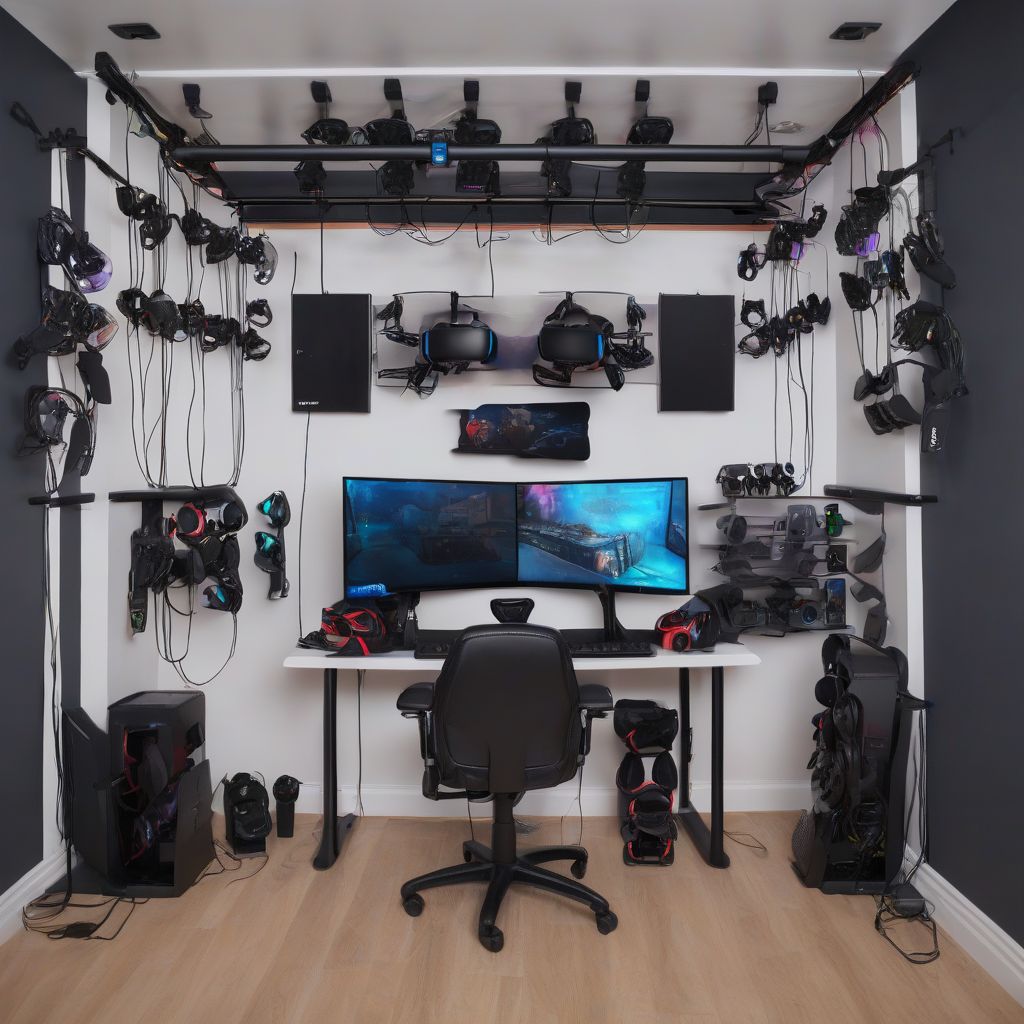Imagine stepping into a world entirely different from your own, where the limitations of reality melt away, and adventure awaits around every corner. That’s the promise of virtual reality (VR) gaming. But what if your experience is plagued by blurry visuals, lag, or discomfort?
Optimizing your VR gaming setup at home is crucial for unlocking the full potential of this immersive technology. It’s about crafting an environment and experience that’s not just playable, but truly incredible.
Creating the Ultimate VR Playspace
Think of your VR space as more than just a corner in your living room – it’s your gateway to another dimension! Here’s how to make it amazing:
1. Space is the Name of the Game: VR requires movement, and plenty of it. Ensure you have a clear area free of furniture and obstacles. A minimum of 6ft x 6ft is ideal for most games, but bigger is always better for room-scale VR.
2. Lighting is Key: Too bright, and you’ll get glare on your headset lenses. Too dark, and your tracking might suffer. Opt for soft, diffused lighting or dimmable lights for optimal visibility without compromising immersion.
3. Mind Your Cables: Tangled cords are a VR gamer’s worst nightmare. Use cable management solutions like ceiling pulleys, wall mounts, or even strategically placed hooks to keep things tidy and safe.
 VR Cable Management
VR Cable Management
4. Temperature Control: VR can get you moving, which means things can heat up quickly. Ensure good ventilation or consider a fan to stay comfortable during those epic gaming sessions.
Fine-Tuning Your VR Hardware for Peak Performance
Your VR headset is your window to virtual worlds, but even the most powerful device benefits from a little optimization:
1. Headset Positioning is Crucial: Adjust your headset for clarity and comfort. The sweet spot ensures the clearest visuals, while proper weight distribution prevents neck strain during long play sessions.
2. IPD Adjustment Matters: Interpupillary distance (IPD) – the distance between your pupils – varies between individuals. Most headsets offer IPD adjustment to align the lenses with your eyes for optimal clarity.
3. Tracking Perfection: Whether you’re using inside-out tracking or external sensors, ensure they are positioned correctly. Clean your sensors regularly and calibrate your setup according to the manufacturer’s instructions for accurate and responsive tracking.
4. Controller Care: Keep your controllers charged and calibrated for a seamless experience. Consider rechargeable batteries and invest in grips or straps for added comfort and control during intense gameplay.
Optimizing Your PC for a Smooth VR Experience
VR demands a lot from your PC. Here’s how to make sure it’s up to the task:
1. Meet the Minimum Specs (and Exceed Them): Check the recommended system requirements for your chosen VR headset and games. Aim for a powerful graphics card, ample RAM, and a fast processor for the best performance.
2. Driver Updates are Your Friend: Keep your graphics card drivers, audio drivers, and operating system up to date. These updates often include performance improvements and bug fixes specifically for VR.
3. Background Processes are the Enemy: Close any unnecessary applications running in the background while playing VR games. This frees up system resources and ensures a smoother, lag-free experience.
4. Overclocking (Proceed with Caution): For experienced users, overclocking your GPU can squeeze out extra performance. However, do so cautiously and monitor temperatures to avoid damaging your hardware.
Software Tweaks for an Enhanced VR Experience
Don’t underestimate the power of software settings in optimizing your VR journey:
1. Graphics Settings Matter: Adjust in-game graphics settings to find a balance between visual fidelity and performance. Lowering settings like anti-aliasing and shadows can significantly improve frame rates without sacrificing too much visual quality.
2. Supersampling for Sharper Visuals: Supersampling renders the game at a higher resolution than your headset’s native resolution, resulting in sharper visuals. Experiment with supersampling levels to find the sweet spot for your system.
3. VR Performance Tools Are Your Ally: Many VR headsets come with companion software that offers performance monitoring, optimization tools, and customization options. Utilize these tools to fine-tune your VR experience.
Beyond the Tech: Tips for a Comfortable VR Adventure
1. Take Breaks and Stay Hydrated: VR can be incredibly immersive, but it’s important to take breaks to avoid eye strain, motion sickness, and fatigue. Stay hydrated and listen to your body’s signals.
2. Start Slow and Gradually Increase Playtime: If you’re new to VR, ease into it gradually. Start with shorter sessions and gradually increase your playtime as you acclimate to the experience.
3. Communication is Key: If you’re playing with others, communicate clearly and be mindful of your surroundings. Accidents can happen in the heat of the moment, so establish boundaries and stay aware.
Conclusion: Your Virtual World Awaits
Optimizing your VR gaming setup at home is an ongoing journey of discovery and fine-tuning. By following these tips, you can create an immersive and awe-inspiring VR experience that transports you to new worlds and unforgettable adventures. Remember, the key is to prioritize comfort, performance, and above all else, pure, unadulterated fun. Now, go forth and explore the vast possibilities of virtual reality!
[amazon bestseller=”VR Headset”]
